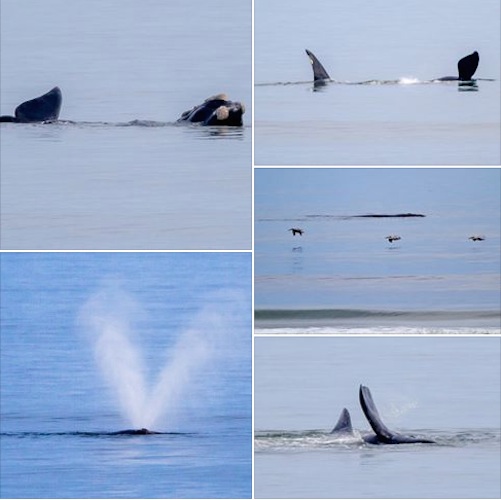NEW SMYRNA BEACH, Fla. -- Veteran surfer Kem McNair not only is handy with a surf board, but with a camera as well as demonstrated by awesome stills he shot of a right whale swimming about 100 yards from the shore this afternoon.
"I followed it from 27th street to Hiles in Silver Sands.," he said of the whale. "(It) stopped at Hiles and started slapping (its) pectoral side flipper on the water. (It) did it about 10 or 15 times and since there was no wind you could here it plain as day."
McNair, who, over the years has captured spinner sharks, dolphins and other creatures of the sea, said of today's discovery, "Its always exciting to try and keep up with them. The whale moved from Flagler Avenue to Hiles in about and hour and a half."
Asked why he seems to be far more observant than other beach-goers, 61-year-old Kem McNair ,who has surfed these waters for half a century now, said perhaps because he's just more observant -- more patient. And perhaps as he sees it, he truly appreciates "the wonderment of these beautiful creatures."
"I am always in awe at how special of a place we live," McNair told Headline Surfer®. "You just have to get out and look to see the most amazing things. I just think people don't slow down and take time to observe the natural world and all its beauty. It's there all the time. You just have to open your eyes."
 Asked why he seems to be far more observant than other beach-goers, 61-year-old Kem McNair, who has surfed these waters for half a century now, said perhaps because he's just more observant -- more patient. And perhaps as he sees it, he truly appreciates "the wonderment of these beautiful creatures."
Asked why he seems to be far more observant than other beach-goers, 61-year-old Kem McNair, who has surfed these waters for half a century now, said perhaps because he's just more observant -- more patient. And perhaps as he sees it, he truly appreciates "the wonderment of these beautiful creatures."
"I am always in awe at how special of a place we live," McNair told Headline Surfer®. "You just have to get out and look to see the most amazing things. I just think people don't slow down and take time to observe the natural world and all its beauty. It's there all the time. You just have to open your eyes."
 FAST FACTS: Right Whales
FAST FACTS: Right Whales
Right whales are three species of large baleen whales of the genus Eubalaena: the North Atlantic right whale (E. glacialis), the North Pacific right whale (E. japonica) and the southern right whale (E. australis).
They are classified in the family Balaenidae with the bowhead whale. Right whales have rotund bodies with arching rostrums, V-shaped blowholes and dark gray or black skin. The most distinguishing feature of a right whale is the rough patches of skin on its head which appear white due to parasitism by whale lice.
Right whales can grow up to more than 18 m (59 ft) long with the maximum record of 19.8 m (65 ft) and weigh up to 100 short tons (91 t; 89 long tons), significantly larger than other coastal species such as humpbacks, grays, or bryde's, but smaller than blues.
All three species are migratory, moving seasonally to feed or give birth. The warm equatorial waters form a barrier that isolates the northern and southern species from one another. In the Northern Hemisphere, Right whales tend to avoid open waters and stay close to peninsulas and bays and on continental shelves, as these areas offer greater shelter and an abundance of their preferred foods. In the Southern Hemisphere, right whales feed far offshore in summer, but a large portion of the population occur in near shore waters in winter.
Right whales feed mainly on copepods but also consume krill and pteropods. They may forage the surface, underwater or even on the ocean bottom. During courtship, males gather into large groups to compete for a single female, suggesting that sperm competition appears to be an important factor in mating behavior.
Although the blue whale is the largest animal on the planet, the testes of the right whale are actually ten times larger than those of the blue whale – with each weighing up to 525 kilograms (1,157 lb), they are by far the largest of any animal on Earth.
Gestation tends to last a year, and calves are born at 1 short ton (0.91 t; 0.89 long tons) in weight and 4–6 m (13–20 ft) in length. Weaning occurs after eight months.
Source: Wikipedia

 Photos by Kem McNair / For Headline Surfer® /
Photos by Kem McNair / For Headline Surfer® /Asked why he seems to be far more observant than other beach-goers, 61-year-old Kem McNair, who has surfed these waters for half a century now, said perhaps because he's just more observant -- more patient. And perhaps as he sees it, he truly appreciates "the wonderment of these beautiful creatures."

 FAST FACTS: Right Whales
FAST FACTS: Right Whales